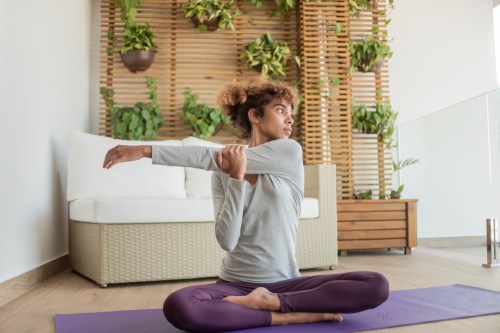Our editors independently select these products. Making a purchase through our links may earn Well+Good a commission
Somatic Exercises Stretch the Stress Right Out of Your Aching Body
Explore somatic exercises to alleviate stress and soothe body aches. Discover effective techniques for relaxation and well-being.

If you’ve ever unrolled your mat for the celestial experience known as Yin yoga, you know that there’s basically one rule: Do nothing quickly. Snail’s pace stretching is highly recommended in more restorative poses.
The same rings true with somatic exercises, Yin-adjacent stretches designed to calm your nervous system by asking you to wade into the sensations in your own body.
What is somatic exercise?
By now, you’re probably wondering what somatic exercise is and where the idea came from. So, let’s dive in.
According to the late Thomas Louis Hanna, PhD, the movement theorist who coined the term, somatic exercises require you to focus on how a certain movement makes you feel by moving your body as gently and compassionately as possible.
“Moving slowly, you give your brain the chance to notice all that is happening in your body as you move,” wrote Dr. Hanna in his book Somatics: Reawakening The Mind’s Control Of Movement, Flexibility, And Health (excerpted by the Somatic Systems Institute). “Slow-motion films are essential in sports training because they allow athletes to study the details of a movement or play. The same goes for focusing attention on the internal sensations of your own movements: The slower you go, the more you perceive.”
Only, instead of studying a fumble (or, you know, whatever actually happens in football), you’re zeroing in on the stretch in your hamstrings, back, or another body part.
Some other examples of somatic exercise include the following, per Charlie Health:
- Yoga
- Dance
- Breathwork
- Posture exercises
- Body scans (where you take the time to think about how each part of your body feels)
Eventually, Dr. Hanna promises your “somatic brain” will take over and you’ll find yourself a more limber and calm human being.
“You must be patient, looking not for a quick fix on your body, but for a genuine, lasting change in your comfort, range of movement, posture, and general functioning. Most importantly, you must be positive in your expectations, envisaging and aiming for the improvement you know your somatic system is capable of,” Dr. Hanna wrote.
Benefits of somatic exercise
Somatic exercise is great for people of all ages, abilities, and fitness levels due to its low-impact, relaxing nature, according to Charlie Health. Here are a few other notable benefits:
- Stress relief
- Pain relief
- Improved posture
- Better balance
- Increased flexibility
- Emotional awareness
YouTube videos to get you started with somatic exercises
Move slowly and with intention when doing somatic exercise, according to the Somatic Systems Institute. Never force your body into a position that feels uncomfortable for you—no movement should be painful.
Let’s get started with the following free somatic exercises at home!
1. Gentle somatic yoga for emotional release (10 minutes)
If you’re already a proud yogi, this video will be a good start place for you. Instructor Brett Larkin offers a class filled with moves you’ll find familiar—with somatic magic sprinkled in here and there. Feel free to move at half speed, if you want.
2. Somatic movement relaxation (6 minutes)
If you scrub quickly through this video, you may be under the impression that Susan Koenig, LCSW, founder of Somatics for You, isn’t moving at all. But you would be gravely mistaken, my friend. Her ever-so-slow movements work into your hips, neck, and more for a full-body stretch that doesn’t even require leaving savasana.
3. Clinical Somatics exercise for lowe back pain relief (12 minutes)
With the help of the folks a the Somatics Movement Center, you’ll target the tricky back pain that so many of us deal with on a daily basis. Again, your body as a whole will barely move, but so much will happen. Believe me.
For a slightly more active flow:
Somatic exercise vs. somatic therapy
While somatic exercise relates to your body, somatic therapy relates to your mind (and your mind-body connection). Somatic therapy benefits include helping people process and recover from trauma, stress, and other unresolved emotional issues, per Harvard Health Publishing. Here’s a non-exhaustive list of what somatic therapy can help treat:
- post-traumatic stress disorder (PTSD)
- depression
- anxiety
- grief
- self-esteem and intimacy issues
Somatic therapy develops an “awareness of bodily sensations, and teaches people to feel safe in their bodies while exploring thoughts, emotions, and memories,” per Harvard Health Publishing. In practice, this can look like techniques such as body awareness (recognizing and relieving body tension spots), pendulation (going from a relaxed state to emotions similar to your trauma, back to a relaxed state), titration (going through a traumatic memory and noticing your physical sensations), or resourcing (recounting what in your life provides a sense of calm and safety).
You can find a qualified somatic therapist via the directories below:
Things to keep in mind before giving somatic exercise a try
Ahead of starting any new exercise program, it’s important to get the green light from your doctor. Somatic exercise, just like any other form of working out, comes with some level of risk, so you want to make sure any injuries or health conditions you may have won’t be an issue.
Because somatic exercise triggers your nervous system, you may experience the following side effects, according to the Somatic Movement Center:
- Muscle twitches
- Muscle pain
- Lack of muscle awareness
- Nausea
- Dizziness
- Headache
If you notice any of the above, it’s okay to take a break, do fewer reps of each exercise, or stop the exercise completely (and consider skipping it in the future). That being said, these symptoms are typically temporary and fade over time as your body gets used to the movement.
It may be helpful to work with someone who specializes in a somatic approach to exercise. You can find a list of trained and certified somatic experts below. If you don’t see anyone in these directories in your area, a local yoga or dance instructor may be able to help.
- Clinical Somatic Educator Certified Practioner Directory
- International Somatic Movement Education and Therapy Association
- Somatic Movement Center Certified Exercise Instructors
- Essential Somatics Practioner Profiles
FAQ
1. What are some examples of somatic exercise?
Dance, yoga, breathwork, posture exercises, and body scans are all great examples of somatic exercises. Learn more above!
2. How often should you do somatic exercise?
You can do somatic sessions as much as every day or as little as one day per week, according to the Somatic Systems Institute. However, the more often you do it, the faster you’ll be able to reap the performance and flexibility benefits. A typical workout can last anywhere from 20 to 45 minutes, but you can opt for quicker 5- to 10-minute sessions if you’re strapped for time.
3. Are somatic exercises good for you?
The short answer: yes. A somatic movement practice has physical benefits like improving your balance, posture, and flexibility and mental benefits like stress relief and more emotional awareness. Check out more somatic exercise benefits above!
Sign Up for Our Daily Newsletter
Get all the latest in wellness, trends, food, fitness, beauty, and more delivered right to your inbox.
Got it, you've been added to our email list.










